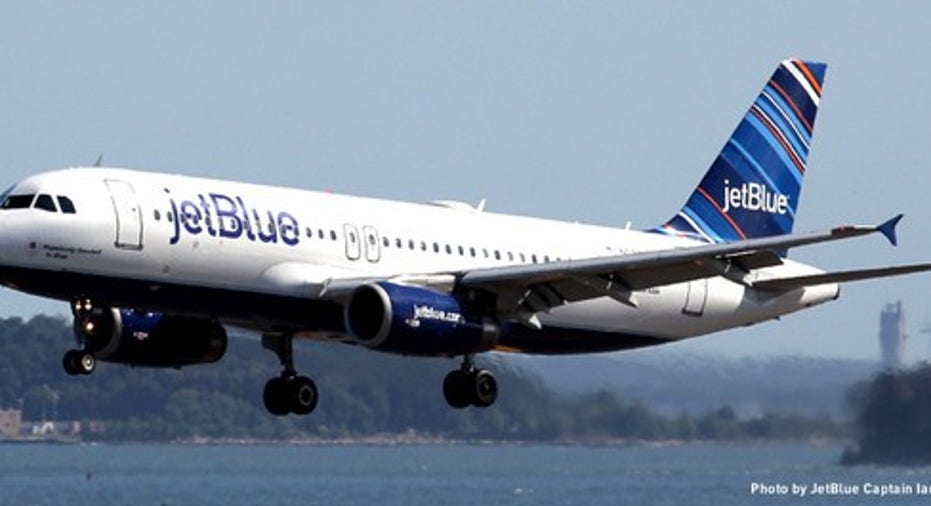These 2 Airline Stocks Are Ready to Take Off

Spirit Airlines (NASDAQ: SAVE) and JetBlue Airways (NASDAQ: JBLU) are two of the most promising growth companies in the U.S. airline industry. However, they have been frustrating stocks to own for the past couple of years, as JetBlue and Spirit have been slower to recover from the industry's unit revenue downturn than many of their peers.
Investors started to become more optimistic about both companies' prospects in late 2016. Yet JetBlue and Spirit experienced big unit revenue declines once again in Q1 2017.
Fortunately, both carriers seem to be on the cusp of a return to unit revenue growth. This should allow them to stabilize their earnings over the next couple of quarters, before returning to strong earnings growth in late 2017 or 2018.
Spirit sees brighter skies ahead
Back in February, Spirit Airlines forecast that its revenue per available seat mile (RASM) would decline 2.5% year over year in Q1. That would have been better than the 3.6% RASM decline it reported in the prior quarter.
Unit revenue has been declining at Spirit Airlines recently. Image source: Spirit Airlines.
However, Spirit cut its Q1 unit revenue guidance last month, saying that it had underestimated the impact of Easter shifting back to April after falling in March last year. Ultimately, RASM declined 4.3% for the quarter.
The outlook for the rest of the year remains strong, though. In fact, in a recent investor update, Spirit's management said that unit revenue was on track to rise in Q2, excluding the benefit from a later Easter.
Spirit estimates that the Easter shift negatively impacted unit revenue by 3.5 percentage points in the first quarter. Assuming that it will see a corresponding benefit in Q2, the company's guidance implies that RASM will rise at mid-single-digit rate this quarter.
Even with this strong RASM growth, Spirit could face continued margin erosion during the second quarter. CFO Ted Christie has already warned investors that non-fuel unit costs will likely rise at a mid-single-digit rate in Q2, mainly due to the timing of various maintenance projects. Meanwhile, fuel costs are on pace to rise at least 20% relative to the $1.47/gallon Spirit paid for jet fuel in Q2 2016. Spirit would probably need RASM to rise 7% to 8% to hold its profit margin steady.
That said, Spirit Airlines could still return to earnings growth this quarter. Between its rapid capacity expansion and its return to unit revenue growth, Spirit's revenue is likely to rise by nearly 25% in Q2, offsetting its margin decline.
Looking further ahead, Spirit expects non-fuel unit costs to decrease in the third and fourth quarters. Fuel cost comparisons will get easier as the year progresses. The company's efforts to maximize revenue will have had more time to work, as well. As a result, Spirit Airlines' earnings growth is likely to accelerate in the second half of the year.
Conditions improving at JetBlue, too
JetBlue hasn't provided as detailed a forecast for the second quarter yet. (It will do so in conjunction with its Q1 earnings report next week.) However, based on the information it has revealed thus far, it appears that JetBlue's performance could closely mirror Spirit's.
JetBlue and Spirit appear to be facing similar revenue trends. Image source: JetBlue Airways.
For the first quarter, JetBlue's RASM declined by 4.8%. As was the case at Spirit, the Easter calendar shift had a big negative impact on unit revenue. RASM decreased by about 6.5% year over year in March, but that included a roughly 7-percentage-point negative impact from the timing of Easter.
The Easter shift should lift JetBlue's unit revenue by a similar amount in April -- and the company says that RASM would be higher in April than in March even without this benefit.
JetBlue's unit revenue trajectory should be supported by capacity cuts implemented back in February. As a result, RASM will probably increase at a mid-single-digit clip in Q2 and continue rising in the back half of the year.
Like Spirit, JetBlue faces big fuel and non-fuel cost headwinds this quarter. But non-fuel cost growth will slow dramatically in the second half of the year and should be close to zero over the next few years, allowing JetBlue to return to strong earnings growth in 2018, if not earlier.
Plenty of upside here
Shares of Spirit Airlines and JetBlue Airways both carry fairly low valuations due to the companies' recent earnings woes. Spirit stock trades for about 14 times its projected 2017 earnings; JetBlue stock trades for less than 12 times its projected 2017 earnings.
While many other airline stocks are even cheaper, these low earnings multiples indicate that investors don't fully appreciate how much growth potential Spirit and JetBlue have. By next year, both companies will probably be generating double-digit earnings growth. That could drive shares of Spirit Airlines and JetBlue Airways much higher.
10 stocks we like better than Spirit AirlinesWhen investing geniuses David and Tom Gardner have a stock tip, it can pay to listen. After all, the newsletter they have run for over a decade, Motley Fool Stock Advisor, has tripled the market.*
David and Tom just revealed what they believe are the 10 best stocks for investors to buy right now... and Spirit Airlines wasn't one of them! That's right -- they think these 10 stocks are even better buys.
Click here to learn about these picks!
*Stock Advisor returns as of April 3, 2017
Adam Levine-Weinberg owns shares of JetBlue Airways and Spirit Airlines and is long January 2019 $10 calls on JetBlue Airways. The Motley Fool recommends JetBlue Airways and Spirit Airlines. The Motley Fool has a disclosure policy.